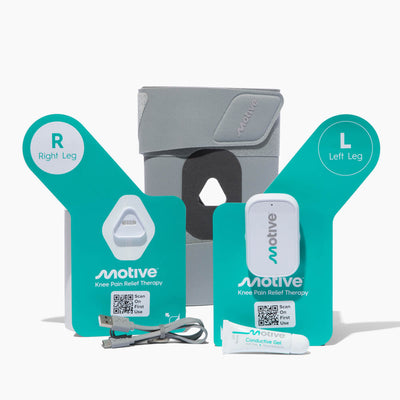
Every step you take shouldn't be a reminder of your knee pain, yet for millions globally, it is a daily reality. Arthritis of the knee, particularly osteoarthritis, the most common type of arthritis, significantly affects mobility and quality of life.
An NHIS study reported that from 2019 to 2021, about 24.2% of women and 17.9% of men in the U.S. were diagnosed with arthritis, affecting all racial and ethnic groups, with non-Hispanic White adults reporting the highest prevalence at 24.6%.
Early detection and proactive management can prevent the condition from escalating and profoundly impacting daily activities. According to orthopedic studies, a significant percentage of adults will experience symptoms of osteoarthritis, about 60% of them women, which underscores the importance of effective management strategies.
In this article, we delve into the symptoms and diagnosis of arthritis in the knees, exploring effective home remedies and necessary dietary adjustments. We will also introduce how integrating Motive therapy into your regimen can significantly enhance your management of knee arthritis for lasting relief.
Understanding Arthritis in the Knees
Arthritis in the knees primarily involves the degeneration of joint tissues and can occur in forms such as osteoarthritis and rheumatoid arthritis, an autoimmune disease. This condition typically affects various structures within the knee joint, including the cartilage, meniscus, kneecap (patella), and ligaments, leading to pain and reduced range of motion.
Age, excessive weight, previous knee injuries, and repetitive stress are risk factors that accelerate osteoarthritis. Understanding how osteoarthritis develops, including the wear of the cartilage and the formation of bone spurs, is crucial for effective management.
Symptoms and Diagnosis of Knee Arthritis
Knee arthritis is a debilitating condition that manifests through various symptoms, such as pain and stiffness. It significantly hampers everyday functions and reduces overall mobility. Understanding these symptoms is crucial for timely and effective treatment to manage pain and prevent further joint damage. This section details the common symptoms of knee arthritis, the importance of early diagnosis, and the diagnostic processes involved.
Symptoms
Symptoms of knee arthritis include persistent joint pain, swelling, reduced mobility, and sometimes, crepitus—a cracking sound when the knee moves. Progression of symptoms often leads to increased discomfort and decreased functionality, making early diagnosis essential.
Early detection allows for more effective management strategies that can significantly alleviate pain and slow the progression of the disease. Without timely intervention, arthritis can severely restrict one’s lifestyle and lead to more complex orthopedic issues requiring surgical solutions.
Diagnosis
Diagnosis typically involves a comprehensive physical examination, review of medical history, X-rays to assess joint space and deformities, and blood tests to rule out other types of arthritis. Consulting healthcare providers is vital to determine the specific form of arthritis and appropriate treatment options, including potential surgical interventions like osteotomy or total knee replacement for severe cases.
Accurate diagnosis enables tailored treatment plans that address both symptoms and underlying causes effectively. This personalized approach may also include recommendations for physical therapy and lifestyle adjustments to enhance quality of life and improve joint function.
Home Remedies for Arthritis Pain Relief
Managing knee arthritis pain can be done without surgical intervention and at home effectively through:
- R.I.C.E Method: The tried and true method of Rest, Ice (using an ice pack), Compression, and Elevation is essential for managing acute arthritic knee pain and swelling, depending on the severity.
- NSAIDs and Acetaminophen: Over-the-counter nonsteroidal anti-inflammatory drugs (NSAIDs) and pain relievers like ibuprofen and naproxen offer temporary pain relief.
- Supplements: Glucosamine and chondroitin, known for supporting joint health, may help alleviate arthritis pain.
- Motive therapy: Incorporate Motive therapy, a cutting-edge device that provides targeted electrical stimulation to strengthen the quadriceps muscles around the knee, enhancing support and reducing pain for those with arthritis.
Exercise and Physical Activity for Arthritis
Maintaining an active lifestyle with exercises tailored for arthritis can enhance joint function and prevent further deterioration. Low-impact exercises such as swimming and cycling reduce stress on the knee joints, while targeted physical therapy can strengthen muscles around the knee, improving support and mobility. Proper warm-up routines are essential to prepare the joints and minimize injury risk during these activities.
Experience lasting relief from knee pain with just 30 minutes of daily use of Motive Knee. This FDA-cleared therapy strengthens the quadriceps muscles around the knee, significantly reducing discomfort and enhancing mobility.
Dietary Adjustments
Diet impacts arthritis significantly, where anti-inflammatory foods can help manage arthritis pain. Foods rich in omega-3 fatty acids, such as fish and nuts, and antioxidants found in fruits and vegetables, can reduce inflammation.
Conversely, foods high in sugar and saturated fats can aggravate inflammation and arthritis symptoms. Maintaining a healthy weight is crucial as excess weight can put additional stress on weight-bearing joints like the knees, exacerbating arthritic pain.
Unlock Enhanced Knee Health with Motive for Arthritis Relief
Experience a revolutionary approach to managing knee arthritis with Motive, which enhances traditional treatments through targeted electrical stimulation. This cutting-edge therapy strengthens key muscle groups like the quadriceps, supporting your knee joint and alleviating pain, making it ideal for chronic conditions such as osteoarthritis or post-traumatic arthritis.
By combining Motive therapy with regular exercise and proper diet, you can profoundly improve knee function and quality of life. We encourage you to integrate Motive into your arthritis management plan for targeted relief and enhanced mobility. Visit our website or consult your healthcare provider to learn how Motive can help lead to longer-lasting pain relief.





